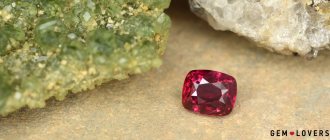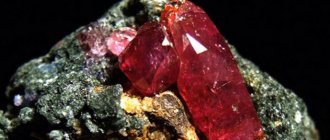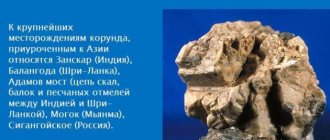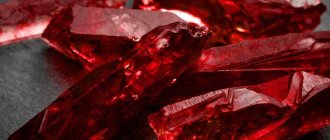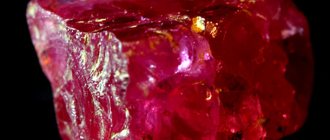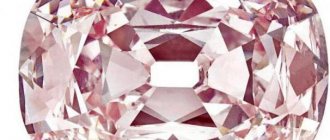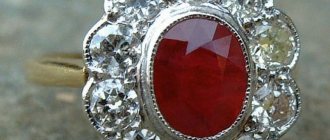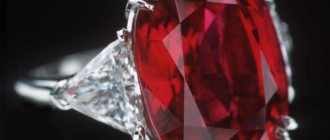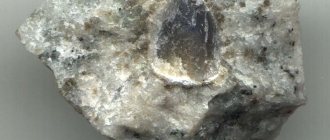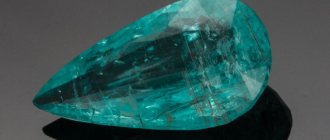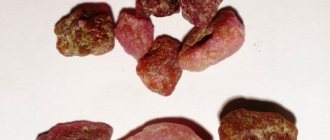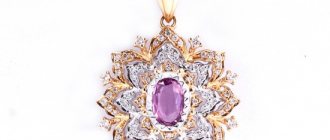Rubies have long held the crown as one of the most expensive colored gemstones. Records of value at auctions have not lasted very long recently. Such a fierce struggle for a new record once again indicates that high-quality rubies will continue to rise in price. Moreover, 6 of the 10 most expensive rubies in the world were sold at auction within the last year and a half.
Advertising - Continued below
The stones, for which many are willing to pay exorbitant sums, have a noble origin: they were all mined at the famous Burmese Mogok deposit and have the rarest “pigeon’s blood” color. Even a small ruby of this color is incredibly valuable.
The Swiss Gemological Institute (SSEF) described a 10.1-carat Pigeon's Blood Mogo ruby as follows: "A natural Burmese ruby of this size and quality is extremely rare and can truly be called a natural treasure."
Since ruby is the patron of the month of July, we present to you the ten most expensive rubies ever sold at auction.
10. Burmese ruby weighing 12.46 carats in a ring with diamonds
$3,721,415 ($298,669 per carat)
Sotheby's auction, Geneva, May 2014
Advertising - Continued below
The ruby is cushion cut and rests between two large triangular diamonds. The ring comes with SSEF and Gübelin reports confirming the origin of the stone and the absence of traces of heat treatment. Also included is a letter describing the exceptional nature of this ruby.
How synthesis technologies developed
The first attempts to synthesize ruby occurred in the mid-19th century. In 1857, chemist Marc Gaudin fused potassium alum with potassium chromate in a clay crucible and obtained crystals weighing about 1 carat. Other researchers were also able to obtain small crystals - H. Senormand, J. Ebelman, but all these attempts had no practical significance.
The breakthrough was the technique proposed by the French chemist Auguste Verneuil. He developed a technology that allows him to grow ruby crystals weighing 20-30 carats in just a couple of hours. Verneuil did not reconstruct low-quality natural stones, but synthesized rubies from a melt of barium and calcium fluorides with the addition of chromium oxide, and later from pure aluminum oxide.
Verneuil's method turned out to be so simple and reliable that it led to the launch of mass production of synthetic rubies. It is still used almost unchanged today, although more than 100 years have passed since its invention.
However, the development of new synthesis technologies has not stopped. Later, methods appeared that made it possible to obtain large crystals with a high degree of purity and perfect structure - the Czochralski method and the zone melting method. Rubies are also synthesized using flux and hydrothermal methods, although they are not widely used.
RusGems ruby grown by hydrothermal method in antique shape
8.99 carat ruby diamond ring from Harry Winston
$3,935,105 ($437,720 per carat)
Christie's auction, Hong Kong, November 2013
The platinum and 18k gold ring features a stunning cushion-cut ruby surrounded by triangular diamonds. The ring is accompanied by a letter from the American Gemological Laboratory, according to which the stone has the rich, saturated color inherent in specimens mined in the Mogok deposit. Traditionally, this color of ruby is called “pigeon blood color.” A skillful cut highlights the richness of the color of this stone, creating a unique play of light inside the ruby.
How to choose a ruby
The price is affected by both weight (carats) and color. Shades of ruby can range from burgundy to crimson. But the standard and most expensive stone is a pure red stone (Pigeon's Blood), which contains a lot of chromium and little iron.
Collection of jewelry with rubies (go to the SUNLIGHT catalog)
To understand the purity of a stone, look at it with a magnifying glass and pay attention to the structure: it should be heterogeneous, interspersed. Cracks and cloudy areas are formed due to crystalline inclusions (zircon, apatite, boehmite, rutile). A perfectly clean sample should make you wonder: is it a fake?
By the way, specialized homology centers carry out professional testing and certification of precious stones: GRS, AIGS, GIA, SSEF, IGI, AGTA, EGL, HRD.
8. 30.2 carat ruby set in diamond ring
$4,265,586 ($141,245 per carat)
Advertising - Continued below
Sotheby's auction, Geneva, May 2011
The 30.2 carat cushion cut ruby has exceptional color. Its splendor is complemented by two pear-shaped diamonds weighing 2 and 2.02 carats. The stones adorn this elegant platinum ring. The product is accompanied by a report from Gübelin confirming the origin of the stone and the presence of signs of heat treatment.
Secondary and indirect factors
Factors that have less influence on the price are the presence of inclusions and information about the ruby deposit . A good specialist may well be able to find out about the origin of a ruby (even taking into account the fact that even stones found nearby can be quite different). Siamese rubies are duller due to the presence of iron, they may contain inclusions in the form of broken thin crystal plates and cavities, while Burmese rubies often contain oriented rutile crystals and hollow channels.
Beautifully arranged rutile needles give Burmese rubies a silky sheen. They will create the effect of a cat's eye in cabochons. And the most valuable asterism is the figure of a pointed star, sliding along the surface of the cabochon as it turns in the so-called star ruby. If the inclusions are minor or have created a beautiful pattern, they will not affect the price, but ideal transparency is a sign of its synthetic origin.
Heat treatment, “healing” cracks and filling cavities reduce the price of the product by half. However, visually such a stone can be simply magnificent. For example, the procedure of filling cracks and cavities with flint glass is also used for star rubies. But it should be borne in mind that stones refined in this way will require special care.
Recently, there has been a tendency to abandon any of these procedures, since defects only emphasize the naturalness of the stone.
It is hardly possible to assess the color of a ruby from a photo; trainings are conducted among novice jewelers on practical assessment of the color of stones. For example, at the Geological Faculty of Moscow State University, where they can also teach you how to distinguish it from red spinel and almandine garnet and talk about methods for determining the dichroism of ruby. GIA color classification system that allows you to navigate the class of ruby by description when choosing an auction.
The Patiño Ruby is a 32.08 carat Mogok ruby in a ring from Chaumet
$6,736,750 ($209,998 per carat)
Advertising - Continued below
Christie's auction, Geneva, May 2012
A 32.08 carat cushion cut ruby sits on a pedestal of trapezoidal diamonds. The ring is accompanied by a report from the Swiss Gemological Institute (SSEF), confirming the Burmese origin of the stone and the absence of traces of heat treatment.
Also included is a letter which states: "The rich red color of the stone, also known as 'pigeon blood', is created by nature thanks to the unique combination of impurities typical of the finest examples of Mogok Valley rubies."
The largest cabochon
When cutting a gem into a cabochon shape, the effect of asterism is most fully manifested. The so-called star gems are cabochons with an asterism effect. In them, the light is transformed into a 6- or 12-rayed star.
The largest cabochon ruby is the cherry-colored Reeves star ruby. At 138 carats, it is recognized as the largest and most beautiful star ruby.
Another ruby cabochon is the star De Long. A third less than the leader in weight, but also very large (100.32 carats).
Cartier diamond ring with 29.62 carat Mogok ruby
$7,379,953 ($249,154 per carat)
Sotheby's auction, Hong Kong, April 2014
Advertising - Continued below
The stone has a rich color, which is an inherent quality of rubies from the famous Burmese valley. A worthy setting for it was a ring from Cartier, one of the most respected jewelry houses in the world. There are no traces of heat treatment on the ruby, and the unique combination of noble color and large size makes it an extremely valuable stone.
Largest faceted
This title rightfully belongs to Rubin Niilanjali with a double 12-pointed star. Discovered in 1988 and included in the Guinness Book of Records as the largest mineral with two stars. Weight - 274 grams.
The most famous rubies in the world
Queen Elizabeth II Tiara
The ruby tiara was made in 1973 for the Queen of England by her order, and has not yet been worn by anyone else. Elizabeth II provided all the stones for decoration to the jewelers from her own “reserves”. The tiara contains 96 diamonds and many rubies, the number of which, according to the Burmese who gave them, corresponds to the number of diseases that the stones will help cope with. The tiara is made in the form of a magnificent pink wreath (as you know, scarlet roses are one of the symbols of England). Admire this beauty!
Rubin Elizabeth Taylor
The diamond ring with red corundum, given to the actress in 1968 by her husband Richard Burton, weighs 8.24 carats. Before the auction it was valued at $1.5 million and sold for $4.2 million.
Ruby Maniraja
Inserted into a ring in the form of diamond beads in platinum. The weight of the gem is 13.26 carats. He has such outstanding qualities that he is nicknamed the “King of Jewels.” Estimated by experts at $8-10 million, sold at Sotheby’s in 2022 for $10.5 million.
By the way
There are several famous jewels that have gone down in history as rubies, but in reality they are not rubies. The so-called Caesar Ruby is an original crimson-colored stone, shaped like a bunch of grapes, and is actually red tourmaline. The Black Prince's Ruby, or the Bloody Ruby from the Crown of the British Empire - spinel. The Timur Ruby, owned by the Sheikh of Kuwait, also turned out to be a spinel.
The prices for the largest rubies in the world are prohibitive. This is understandable, because the dispute between diamonds and rubies for unsurpassed beauty is often won by red corundums. Unique precious gems are the heritage of humanity, and it would be fair to place them all in national diamond funds for public display.
Mogok ruby weighing 10.1 carats on a diamond brooch from Cartier
$8,428,127 ($834,468 per carat)
Christie's auction, Hong Kong, November 2014
Set with square, triangular and rectangular diamonds, the ethereal octagonal platinum piece is centered on a 10-carat cushion-cut ruby. The piece is accompanied by a report from SSEF confirming the authenticity of the ruby's color. Also included is a letter describing the outstanding characteristics of the stone. Ruby is distinguished by its elegant cut, impeccable clarity and bright, rich color.
The magic of red stones
Fiery red stones may have been the eyes of a dragon in the past, as an ancient Eastern legend says. Fascinating, hypnotizing - if huge snakes existed, they would definitely look at the world with two ruby drops.
Already 2000 years ago, people began to attribute magical properties to rubies. For example, it was believed that ruby enhances the good and bad qualities of nature: an evil and powerful person with such decoration can become an even greater tyrant, and vice versa.
Ruby is still used as a talisman to protect against the evil eye, envy and slander.
The red mineral will help those who are overcome by doubts and uncertainty, and will restore harmony, peace and vitality.
It is a stone of health, prosperity, greatness and success.
For Aries, such an amulet will restore mental strength and help get out of a depressive mood. This stone will give Scorpio confidence and push them to new beginnings. Gemini will be given flexibility and restraint. Ruby color will help Leos achieve their goals.
But Aquarius and Virgo need to be careful with such a stone: they may not be able to withstand its power.
2. 8.62 carat Graff ruby set in a diamond ring
$8,600,410 ($997,727 per carat)
Advertising - Continued below
Sotheby's auction, Geneva, November 2014
In November 2014, a Burmese ruby weighing 8.62 carats was auctioned at Sotheby's Geneva. Its price was 8,600,410 dollars, and it was only two thousand dollars short of the price of a million per carat.
An 8.62 carat cushion cut ruby supported by two triangular diamonds. The ring is also set with smaller diamonds and features the Graff logo. The product is accompanied by reports from SSEF and Gübelin, according to which the ruby is of Burmese origin and does not show any traces of heat treatment.
From the letter from SSEF, which also accompanies the piece: “This stone is of good size and clarity, which combines well with the skillful cut. Microscopic inclusions are a characteristic feature of rubies mined in the famous Mogok Valley (Myanmar)... The rich red color of the stone, also known as “pigeon blood color”, is due to the unique combination of impurities typical of the best examples of Mogok Valley rubies.” .
Cost of artificial rubies
In Soviet times, we dealt with synthetic or refined rubies. How do these stones differ from natural ones?
- A refined ruby is a ruby of natural origin that has undergone processing due to its low quality. The price of a refined stone will be about $30, and the quality may be much lower than that of a synthetic one.
- A synthetic ruby is ruby grown in a laboratory. There are such laboratories in Europe and Russia. It will not be inferior to its natural counterpart, but a carat of synthetic ruby can cost only $2. Artificial stones are more often used for industrial purposes; their appearance in jewelry makes it possible to significantly expand the range of designer products.
Determining which ruby is in front of you is very simple. As a rule, real stones contain small inclusions, are not so transparent and differ from each other. To protect yourself when purchasing, be sure to require a certificate. All jewelry with precious stones must have it.
Price for synthetic analogues
Synthetic crystals are produced today in Switzerland, Germany, the USA and many other countries. They are made from molten corundum. Initially, they have a transparent texture. However, with the help of additives, the crystals are given the required shade.
An artificial ruby looks much better than a natural one. However, its price is 2 times less. Synthetic crystals are commonly found in jewelry.
The cost of rubies depends on many factors. This parameter is influenced by the deposit, shade, size.
Medicinal properties
Star ruby has strong energy, which can influence the state of the body as a whole:
- The stone has a beneficial effect on the psycho-emotional background - it improves mood, instills confidence, relieves fears and anxiety, and normalizes sleep.
- The star mineral helps women in the treatment of infertility and diseases of the genitourinary system.
- The mineral strengthens the immune system, promotes rapid healing of wounds and recovery from illnesses.
- It has a beneficial effect on the hematopoietic system, normalizes blood pressure, and increases vascular tone.
To manifest its healing properties, a ruby is applied to a problem area and a beam of light is directed at it. An equally effective remedy for healing diseases is water infused with star ruby. The stone is immersed in clean cold water overnight, which is then drunk or used for washing.
What is more expensive - emerald or ruby
Similar situation. It is impossible to accurately answer which of these gems is more valuable and is valued more expensive. It all depends on the quality of the stones, cut, weight, deposit and many other indicators.
Drawing a conclusion from the above, we can say the following: ruby is a gemstone of the first order. Compared to his “brothers” from the same group, he has the same value and significance. It is almost impossible to answer the question of which mineral is more expensive unless you evaluate specific specimens. The cost of gems is influenced by many factors, which, of course, are taken into account when selling.
Magic properties
One of the main magical properties of star ruby is the ability to influence a person’s destiny. The stone enhances the manifestation of personal and characteristic qualities, therefore it directly depends on its owner whether these changes will be positive or negative. Only brave and strong-willed individuals will be able to curb the energy of this mineral and direct it in the right direction.
The star ruby is a strong talisman not only against the machinations of ill-wishers, but also against dangers, adversity and natural disasters. The stone is recommended to be worn by children and pregnant women to protect themselves from the “evil eye”.
This mineral develops leadership qualities, perseverance and desire for goals. At the same time, it teaches wisdom and making informed decisions. Star ruby can enhance a person's desires. The main thing is that these desires do not overshadow ambitions and dishonesty.
Subject to hard work, the star stone will have a beneficial effect on the financial situation of its owner.
